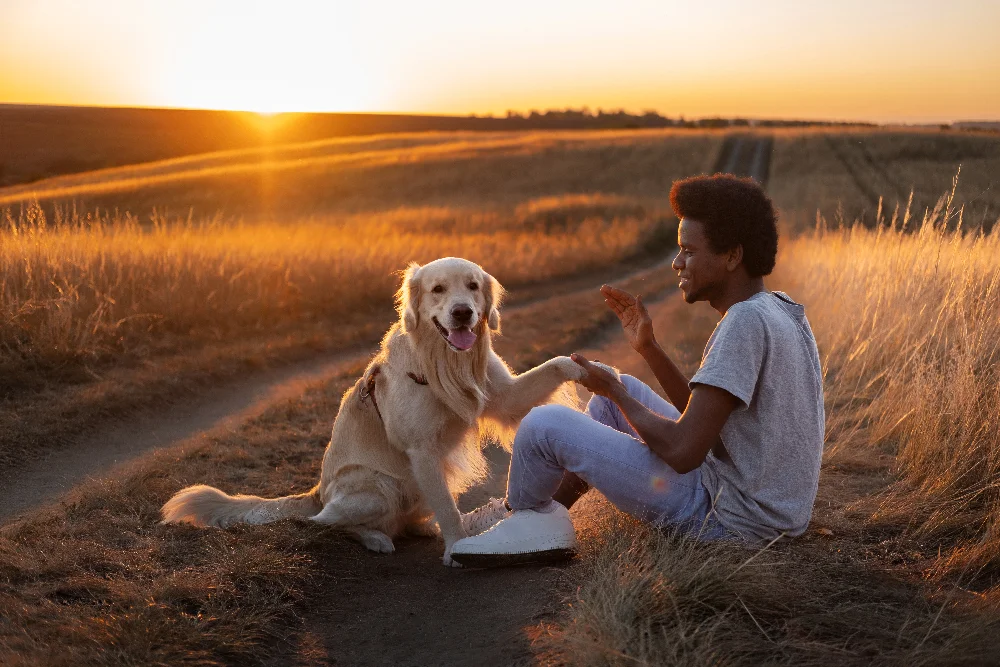I remember the first time my Labrador, Benny, met my toddler nephew. Benny wagged his tail, crouched low like he was playing with another pup, and gently nudged the baby with his nose. My sister laughed and said, “He thinks he’s just found himself a tiny dog!” That moment stuck with me. It made me wonder: Do dogs see us as their human pack… or do they genuinely think we’re just oversized dogs with oddly hairless paws?
This question, as playful as it sounds, taps into something far deeper than curiosity. Understanding how dogs perceive humans isn’t just entertaining; it strengthens our bond with them, improves training, and even helps prevent behavioural issues. Let’s dig into what science, behaviourists, and first-hand dog lovers have discovered.
How Do Dogs Perceive the World?
Before we get to whether dogs think we’re big dogs, it’s crucial to understand how dogs see the world in general. Dogs rely heavily on scent, body language, tone of voice, and social structure. According to a 2014 study published in Current Biology, dogs process faces and emotions in a similar part of their brain as humans do—showing a surprising level of social intelligence.
But here’s the catch: they don’t necessarily view the world through the same lens as we do. Dogs are masters of interpreting subtle signals in body posture and scent. While we rely mostly on visual cues and spoken words, dogs tune in to pheromones, movement, and tone far more.
Dr. Juliane Kaminski, a psychologist at the University of Portsmouth and dog cognition researcher, explains:
“Dogs are uniquely sensitive to human cues, more so than any other species. But that doesn’t mean they think we’re dogs—they treat us differently.”
Do Dogs Think Humans Are Dogs?
The short answer: No, but they include us in their social hierarchy as if we were part of the pack.
Dogs understand that humans aren’t the same species. They respond to us differently than they would another dog. For instance, dogs greet each other by sniffing rear ends. They don’t usually do that to humans (unless you’re really close to the dog). Instead, they might jump up to lick your face or wag their tails in excitement.
This behavioural difference tells us something fundamental: dogs adapt their behaviour when interacting with us. And that suggests they know we’re not dogs.
Pack Mentality and Human-Dog Bonding
The old-school idea of dominance and alpha roles in dog training has been largely debunked. What we know now is that dogs form attachments, much like children to caregivers. A study published in Science (2015) showed that dogs release oxytocin—the same bonding hormone released between mothers and babies—when they make eye contact with humans.
So rather than thinking we’re just big canines, dogs see us as attachment figures, companions, or leaders depending on how we interact with them.
Real-Life Observations: What Do Dog Trainers and Owners Say?
I spoke with Hamza Tariq, a certified dog trainer and behaviourist based in Lahore, about this.
“When dogs misbehave, it’s not because they think we’re fellow dogs. It’s often because they’re confused about the rules we set as humans. They need consistency, not dominance.”
Hamza added that dogs often learn human-specific behaviours like opening doors or understanding hand signals—something they don’t do with fellow dogs.
Take this anecdote: I once fostered a rescue German Shepherd who had never lived indoors. At first, she treated me like I was some odd forest creature. But within days, she began watching me closely, mimicking cues, and following me from room to room. It wasn’t that she mistook me for a dog—she was trying to understand how this two-legged pack member operated.
What Science Says About Dogs’ Social Understanding
Research suggests dogs have a remarkable capacity for what scientists call cross-species social cognition.
A 2016 study in the journal Animal Cognition found that dogs can recognise emotional expressions in humans—smiles, frowns, angry faces—even without training. This is a skill most animals, even intelligent ones like apes or dolphins, don’t exhibit without long conditioning.
Dogs Know We’re Different
Here’s what dogs don’t do with humans:
- Mounting to assert dominance (except when confused or untrained)
- Play bowing in the same way they do to initiate dog-dog play
- Growling during food guarding the same way they do with dogs
This differentiation means dogs adjust their behaviour. They don’t treat us like fellow dogs, but rather, like something else entirely—important, social companions.
Canine Intelligence and Human Recognition
Studies have also shown that dogs can distinguish between humans and other animals visually. A 2013 study in Animal Cognition showed that dogs could pick out their owner’s face from photographs, even when mixed among other humans and dogs.
Dogs and Human Commands
Another big clue: language comprehension. Border Collies, like the famous Chaser, have been shown to understand over 1,000 words. That’s not something you do with fellow dogs. That’s a cross-species connection.
So, while your Golden Retriever might bark at a stranger like he would at an unfamiliar dog, he’s also capable of recognising your mood, reading your facial expressions, and responding to your voice tone—skills tailored only for humans.
So, What Do Dogs Think We Are?
While it’s unlikely dogs think we’re dogs, they do:
- View us as family or attachment figures
- Adapt their behaviour uniquely for us
- Understand our communication cues (much better than other animals)
- Include us in their social world, but on a separate mental tier
Dr. Stanley Coren, canine psychologist and author of The Intelligence of Dogs, puts it well:
“Dogs don’t see us as dogs. They see us as something extraordinary, a different species with whom they can form a deep, meaningful bond.”
How Can We Use This Insight to Be Better Pet Parents?
Knowing that dogs see us as unique companions, not big dogs, can reshape how we treat and train them:
1. Communicate Clearly
Dogs respond best to consistent cues and tone. Don’t expect them to “just know” what you want.
2. Avoid Dominance-Based Training
Focus on positive reinforcement rather than outdated alpha-theory methods.
3. Respect Their Differences
Dogs experience the world through scent, movement, and emotion. Use that to your advantage.
4. Engage Emotionally
Bond through eye contact, touch, play, and routine. Your dog understands much more than you think.
FAQ:
Do dogs know humans aren’t dogs?
Yes, dogs can differentiate humans from dogs through scent, appearance, and behaviour.
Why do dogs sometimes treat humans like dogs?
Some behaviours (like licking faces or jumping) mimic dog interactions, but they’re adapted forms for bonding.
Do dogs understand human emotions?
Yes. Studies show dogs can read facial expressions and react to human moods.
Can dogs understand human language?
To some extent, yes. Some dogs know hundreds of words and associate them with actions or objects.
Final Woof
Dogs don’t think we’re just big, clumsy canines. They know we’re different—and they adore us because we’re different. They adapt to our ways, learn our cues, and form deep emotional bonds with us. Understanding this makes us better companions, trainers, and caretakers.
So next time your pup tilts their head at you mid-sentence or curls up next to you after a hard day, remember: you’re not just part of the pack. You’re something even more special.
Have you ever felt like your dog sees you in a uniquely human way? Drop your story in the comments below—we’d love to hear it!
Read Also: What If Our Dreams were Subtitled?




